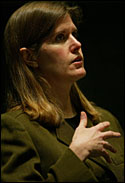The green womb
Sandra Steingraber was a fitting choice to deliver the first Rachel Carson Series lecture on Tuesday, December 3. The series commemorates the 40th anniversary of the publication of Carson's seminal environmentalist text, Silent Spring. Steingraber is a scientist (she has a PhD in biology), activist and author of several books about environmental issues. Among Steingraber's many accolades, the Sierra Club once dubbed her "the new Rachel Carson," and last year she received the biennial Rachel Carson Leadership Award from the late trailblazer's school, Chatham College. But when Steingraber took the podium in the Fieldhouse Auditorium, she revealed a connection to Rachel Carson that extends beyond namesake recognition.
 Activist Sandra Steingraber
Activist Sandra SteingraberPHOTO: Andrew Dobrowolskyj |
|
Steingraber spoke of her close study of Carson's celebrated prose, admitting to a writerly fascination with the inner workings of "the carpentry of her poetic voice." She was deeply inspired by Carson's clear-eyed examination of the corruption of industry, leading to conflicts of interest that often sacrifice the greater good for the greater profit. Carson's incessant belief in "the public's right to know" is tempered with an optimistic search for better alternatives because "despair is not an option."
"I'd like to believe," Steingraber said, "that we're labouring in the same vineyard."
Steingraber's and Carson's lives have two other aspects in common -- being a mother and a cancer patient (Carson died from breast cancer less than two years after the publication of Silent Spring). Unlike Carson, who feared detractors would spin these factors to discredit her scientific work, Steingraber uses the personal to infuse her science with humanity. In Living Downstream: An Ecologist Looks at Cancer and the Environment, she examines cancer from a human rights point of view; in her latest book, Having Faith: An Ecologist's Journey to Motherhood, she frames an examination of the ecology of pregnancy within a personal narrative, from which she drew her lecture.
"Women's bodies are the first environment for all of us." Steingraber used the wording of Katsi Cook, a Mohawk midwife and environmental activist. Starting with what she calls her "birds and bees" lecture, Steingraber discussed the various ways toxins can taint this environment. She explained the importance of individually addressing each stage of fetal development, because scientific thought now believes that the timing of toxic exposure -- not the volume of dosage -- is the deciding factor in fetal health. (For example, x amount of toxin y received at 12 weeks may be far more detrimental than the same dose at, say, 10 or 15 weeks.)
Steingraber worked through a shocking laundry list of environmental causes and fetal effects. She cited studies that show the incidence of birth defects increases the closer a pregnant woman's proximity to a farm. (These further increase when conception occurs in springtime, when pesticide use is highest.) She talked about how PCBs and DDT alter calcium flow in the uterine muscles, shortening gestation periods by triggering early labour, and about the dangers of chemically altering brain architecture during the crucial neural development occurring during the fifth and sixth months of pregnancy.
Much time was devoted to deconstructing the threat of methyl mercury -- proven to damage fetal neurological development -- in seafood. Mercury is naturally present in coal, she explained, which is harmless so long as the coal remains deep inside the Earth. The trouble starts when that coal is mined, then burnt for fuel: the mercury becomes vapour, which enters the air. This vapour soon finds its way into bodies of water, where it hooks up with anaerobic bacteria, becoming methyl mercury. This methyl mercury is consumed by tiny organisms, in turn consumed by bigger organisms, and so on up the food chain. "If we remember Newton's Law," Steingraber said, "we know that matter cannot be destroyed." And so these levels of methyl mercury become increasingly significant by the time they reach the large predatory fish (e.g., tuna) at the top of the chain -- and even more so once humans eat these same fish.
Such contamination doesn't just affect pregnancy, either. A breastfeeding infant is even one step higher in the food chain. "There are two true things about breast milk," Steingraber asserted. "One: it is absolutely the best food for infants. Two: it's the most chemically polluted food on the planet.
"So the question isn't 'How many tuna sandwiches is it safe for a pregnant woman to eat?' but rather 'How do we get that mercury out of the food chain entirely?'"
Steingraber closed by reading the childbirth scene from Having Faith, tempering the evening's unsettling forecast with a funny, painful, emotionally charged -- and ultimately joyful -- snapshot of the childbirth experience.
"I always like to remind my listeners and myself," she concluded, "that this is all about the mysteries of human life."
The Rachel Carson Series is a presentation of the Beatty Memorial Lectures Committee. The series continues the week of March 24, 2003, with Herman Daly, author and former senior economist in the environment department of the World Bank.

